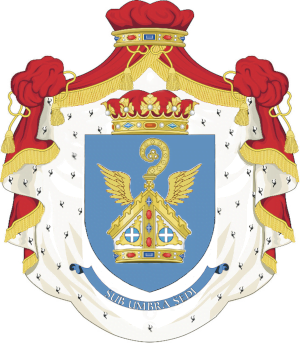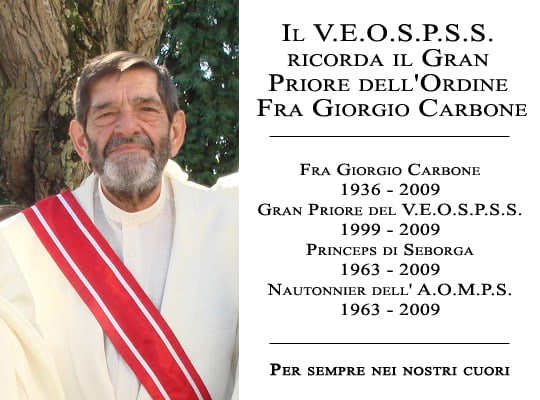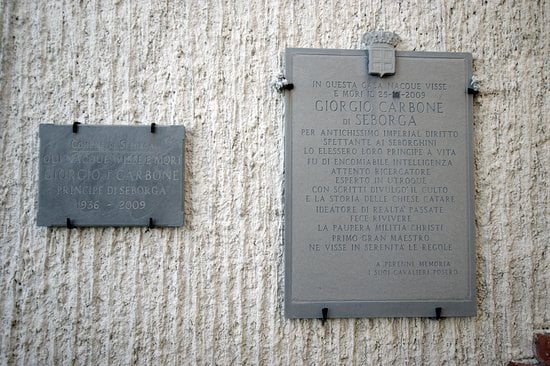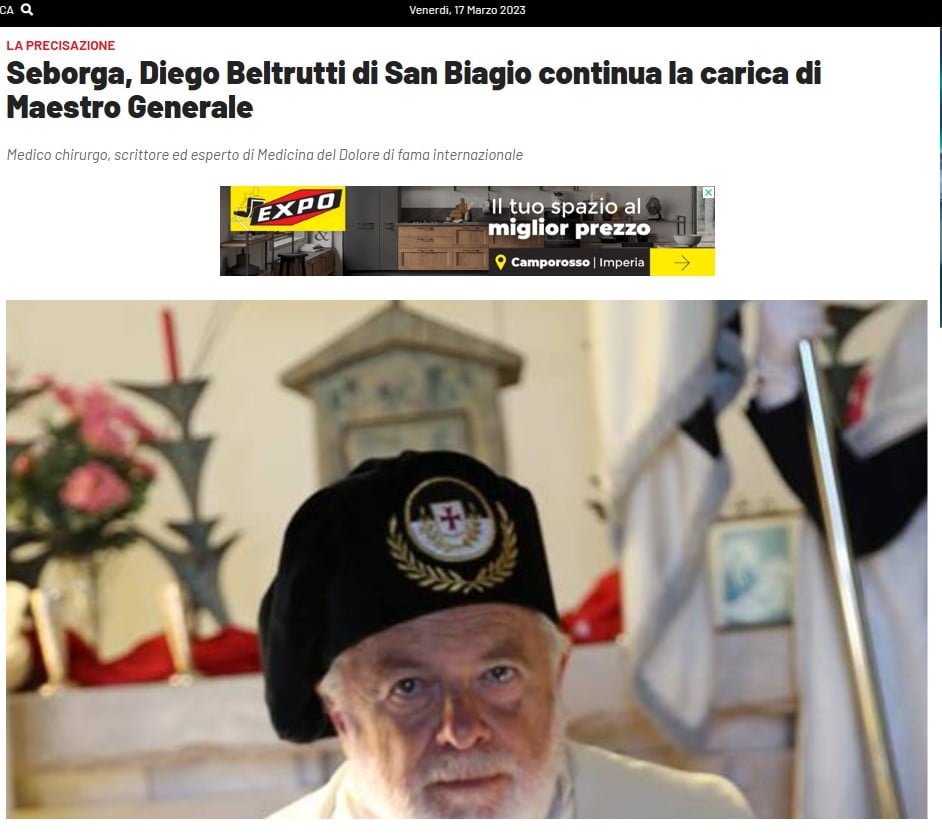Those who look for information on the internet concerning the Principality of Sabourg, vulgarly known as the Principality of Seborga, are sure to find a considerable number of web pages relating to ‘princes and principalities’ that have nothing to do with the monastic state that existed in the Middle Ages. The purpose of this article is to answer as clearly as possible the question of many real and virtual visitors to Seborga: why are there so many ‘princes and principalities’ in Seborga that claim the title without possessing the religious prerogative?
Unfortunately, the main reason lies in the removal of monks from Seborga almost three centuries ago, which has generated since the eighties of the last century various claims to the territory of Seborga by certain residents known as ‘seborghini’, together with self-styled nobles, aristocrats and knights.
Unfortunately, these claims of various kinds and interests are foreign to the properly Christian aspect of the medieval principality. Some claim to be heirs of Napoleon, others of other imperial or aristocratic families that historically had no connection with the monks of Seborga. Thus by using ‘improper revelations’ they have created new and peculiar versions of the ancient principality
This phenomenon has resulted in a significant production of unreliable historical sources, which will be difficult for the history enthusiast or tourist to attain.
Giorgio Carbone, the self-proclaimed prince
The association he founded in the 1980s is known as the ‘Principato di Seborga’, which would appear not to be legally established in Italy even though it is located on Italian territory. This principality created by Giorgio Carbone has a notable folkloristic vocation that attracts many visitors to Seborga and that, thanks to various fortunate inventions, has borne great fruit, raising the notoriety and economic revenue of a small village in the Ligurian hinterland that has now been forgotten.
Giorgio Carbone (1936-2009) had already proclaimed himself prince in 1963 thanks to his appointment as Grand Master of a chivalric order called the ‘White Knights of Seborga’, a direct emanation of the Paupera Militia Christi. This order claimed that the Knights Templar originated the Order of the Temple in Seborga at the behest of Saint Bernard of Clairvaux, to whom the title of Grand Master is also attributed. This myth has no historical correspondence, as the Order of the Temple was founded in 118 in Jerusalem. Carbone was a well-established floriculturist and from the 1980s his presence would become relevant in Seborga, also thanks to the media and the push of those separatist movements that began to take hold in Italy (such as the Lombard League) but also in France. And it was precisely Occitania, with its history of Cathars, Cistercian monks and Templars, that inspired the floriculturist to redefine the historical events of Seborga and for this merit he will be remembered in Seborga on a commemorative plaque as the creator of past realities.
In the 1990s, Carbone, together with several Seborghini and sympathisers, rode on Seborga’s expectation of independence by creating a ‘do-it-yourself’ principality, and involved most of the citizens of the imperial town in the project by granting these Italians the right to elect the Prince of Seborga (i.e. himself).
Undoubtedly, George I was a layman, and therefore the title of religious character of the last abbot cannot be transferred to him, which can only be conferred by religious people to other religious people. Consequently, the prince cannot be designated by the citizens of Seborga because the voters, not being religious, cannot designate a religious office. While the transfer of the title of prince to a layman would interrupt the religious continuity to the monastic principality and therefore there can be no succession of the title.
It is evident that Carbone was not very close to the principles of Roman Catholic doctrine, so much so that one can see in the historical reconstruction of Seborga those theses of Occitan historians who are the authors of the narrative involving Cathars and Roman Christians united together in a crucial event for the history of western humanity. According to Giorgio Carbone’s reconstruction, Seborga as a place of Cistercian and Benedictine settlement became the setting for Cathar and Templar-inspired events that were not only far removed from the monastic vocation of the place, but constituted heresy. It is no coincidence that for these theses Giorgio I is remembered in the commemorative plaque displayed in his honour at Seborga with the phrase: ‘an expert in utroque and with writings he divulged the cult and history of Cathar churches’.
Carbone attributed St Bernard of Clairvaux as Cistercian Abbot to be the successor of Hugues de Payens, also mentioning him as second Grand Master of a Templar order and protector of the Cathars in Seborga. Consequently, the Saint and Doctor of the Church is no longer a Cistercian abbot but a heretical Grand Master and defender of the Cathars, enemies of the Church of Rome and defeated by the Templars.

Portrayal of St. Bernard as a Templar Knight, affixed to the entrance of the ancient Abbey in Seborga
‘In the name of the sovereign people of the Principality of Seborga’.
According to historical and theological sources, the right to elect the Prince of Seborga belonged and still belongs exclusively to those entitled to vote for the office of Prince-Abate, i.e. the presbyters and monks of the Principality of Sabourg, and the title is ‘ad vitam’, and not re-electable every seven years as it was established by Mr. Marcello Menegatto, the successor of Giorgio Carbone.
The natives of the small Ligurian village, known as ‘seborghini’, are those who were actually born in Seborga and have lived there for generations. These could currently be traced back to five or six families. who were perhaps sharecroppers who cultivated the lands of Seborga by paying tithes to the Prince-Abate, but did not however have the right to elect the Prince of Sabourg, a prerogative that we repeat was and is exclusive to members of the religious congregation.
Eventually, the Seborghini could have claimed their independence at the birth of the Italian Republic, as the individual territories were allowed to contest their annexation to the new republican state. And we are not aware that they did so in opposition, perhaps with the expectation of later constituting an eventual Republic of Seborga, as a demonstration of a desire for independence. This hypothetical republic would in any case have had no connection with the tradition of the abbey state, as we have amply explained in the previous parts of this article.
Marcello Menegatto elected prince of the imaginary principality by the people of Seborga
Giorgio Carbone will leave the title of Prince of Seborga in 2009 following his death. After a transition period managed by the lawyer Alberto Romano, his successor will arrive in 2010. This new prince will be elected according to a principle of sovereignty of the people of Seborga and will take the name Marcello I (born Marcello Menegatto). Marcello I unfortunately did not complete his second term, and decided to abdicate and leave Seborga. During his stay in Seborga, he had perhaps become more aware of Carbone’s ideas, and that it was a principality ruled by the Grand Master of the Knights of the Venerabilis Ordo Sancti Sepulchri, and therefore decided to make changes in this regard to the statutes drawn up by Carbone. Changes that threw the knights into crisis, who probably already involved in internal problems, separated and formed two distinct orders: the VEOPSS and VOSS.
It is interesting to point out that the elective office of prince (which for Carbone was for life) was changed by Marcellus I for the duration of 7 years as if electing the head of a republic. Marcellus I will relinquish this title in 2019, and through yet another suffrage of the people of Seboregion, his ex-wife Nina Dobler will be elected princess, completely breaking with any monastic tradition by conferring the title on a woman.
Nina Dobler, the first Princess of Seborga
Mrs Nina Dobler acquired the title of Princess of Seborga after her swearing in in 2020 through the suffrage of the people of Seborga, in continuity with the provisions of her husband Marcello I.
It goes without saying that Mrs Dobler, having to justify her role as princess and first woman at the head of a historically monastic state, also had to change her statutes. Among the changes introduced was an expansion of the prince’s voting rights and the inclusion of new cases. Mrs. Dobler appears on various television programmes, including national ones, claiming that the title of princess of Seborga was conferred on her by the sovereign people of Seborga even though it is evident (see video below) that the mandate conferred on her has no continuity with the ancient monastic state.
We see that the modern seborgian state ruled by Mrs Nina Dobbler is full of contradictions. Just to make a non-exhaustive list: the new head of state is a secular woman of German origin living in the Principality of Monaco. Then again, among the ministers of a state that is supposed to be Christian and therefore in principle opposed to the use of arms, there is also a defence minister who has a mock-Napoleon-like cannon placed in the main square towards the panoramic view and supposedly authorised to fire paradoxically towards the neighbouring territories of the Italian Republic. Then again, under the command of the princess there is also a militia that goliardically entertains people from outside, making them all pass for foreigners even when they are Italians, thus trivialising the testimony of the first monastic state in the history of mankind. In recent days, we also report that the minister of culture has disguised himself as a Benedictine monk, probably to create confusion among the ancient state of monks.
Diego Beltrutti, Prior of the Venerabilis Ordo Sancti Sepulchri (White Knights)
Dr. Diego Beltrutti, is not a religious man but a doctor of Piedmontese origin who claims to be the successor of Giorgio Carbone, being the Prior elected by the Order of the Paupera Militia Christi founded by Carbone, which became VEOPSS and after an internal schism took the acronym VOSS. Beltrutti argues the same theses as Giorgio Carbone did when he decided to claim the title of Prince of Seborga being Grand Master of the Order of the Ordo Sancti Sepulchri.
It is worth noting that in the flag of the principality of George I, which is still used by Dr. Diego Beltrutti, nine blue bands appear on the side of the coat of arms and would represent the 9 founding knights of the Order of the Temple together with a reproduced coat of arms that can be traced back to the Greek monarchy.
Furthermore, Dr. Beltrutti also believes that Seborga became a principality in the year 1079 at the behest of Emperor Henry IV with the conferral of the title of Prince of the Holy Roman Empire on Abbot Adalbert I of Lerino.
We confirm that this reconstruction is not supported by any historical-legal documents.
Moreover, Dr. Diego Beltrutti of San Biagio is said to have publicly defended the Bishop of the Diocese of Ventimiglia and San Remo on the website of the knightly order he manages.







